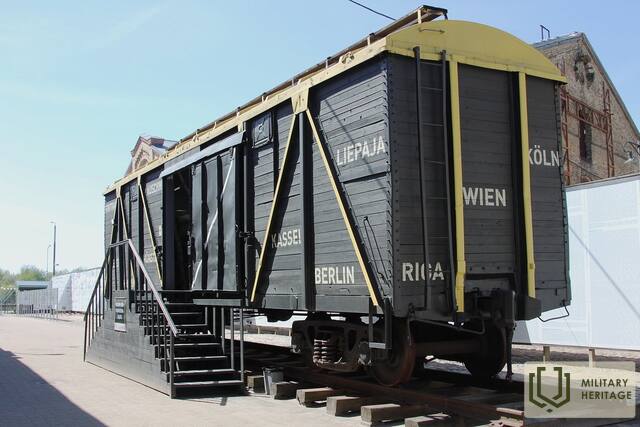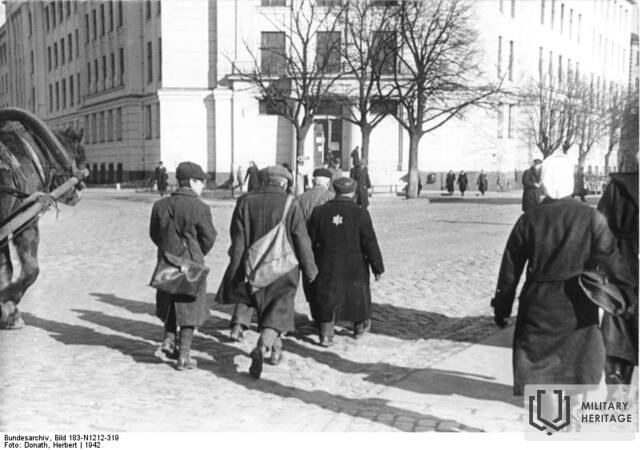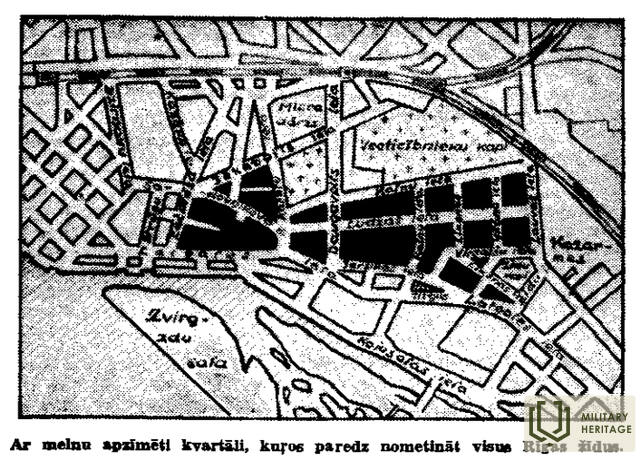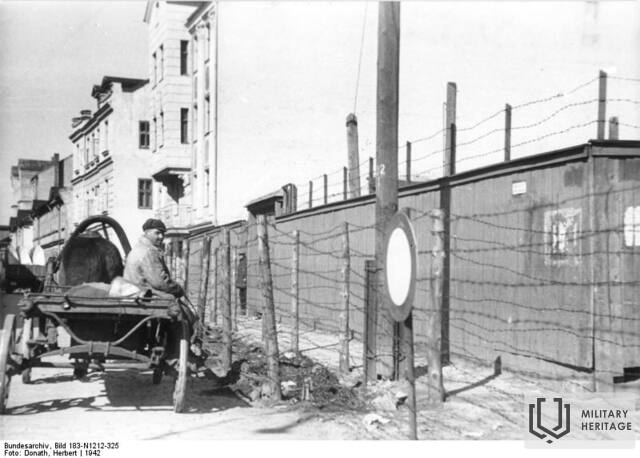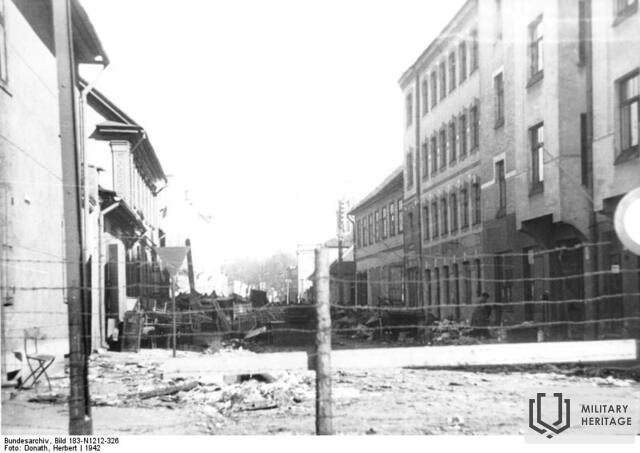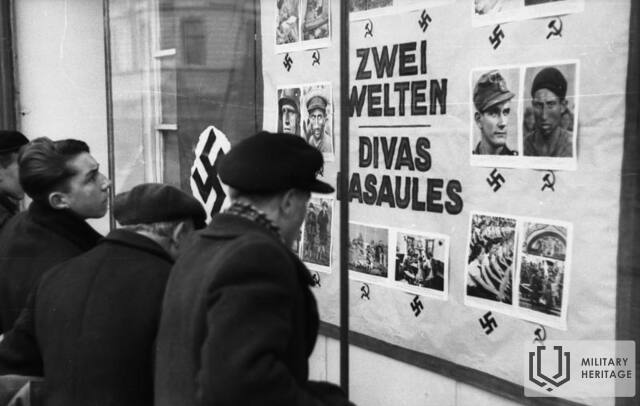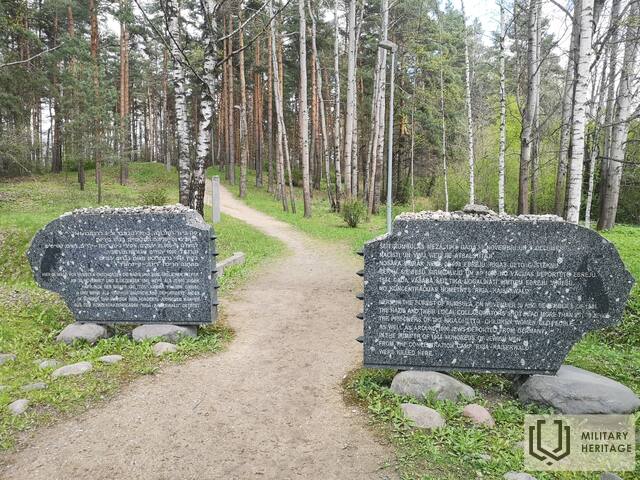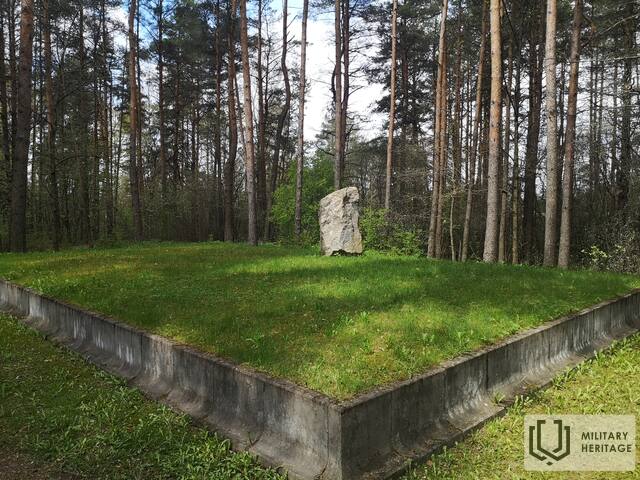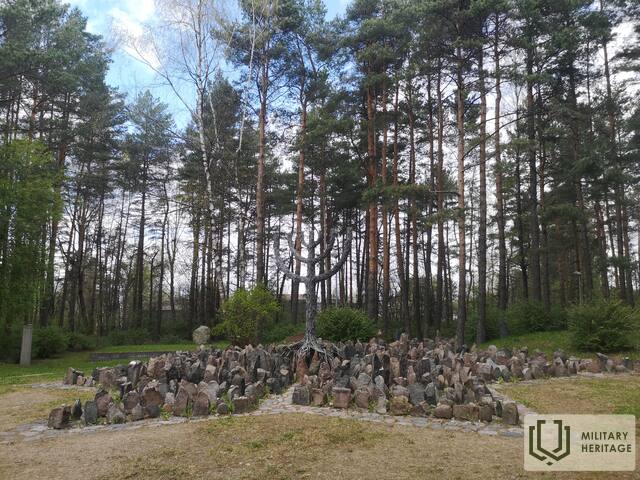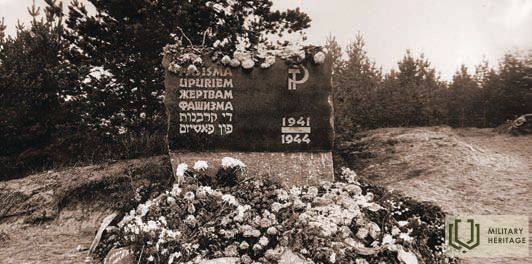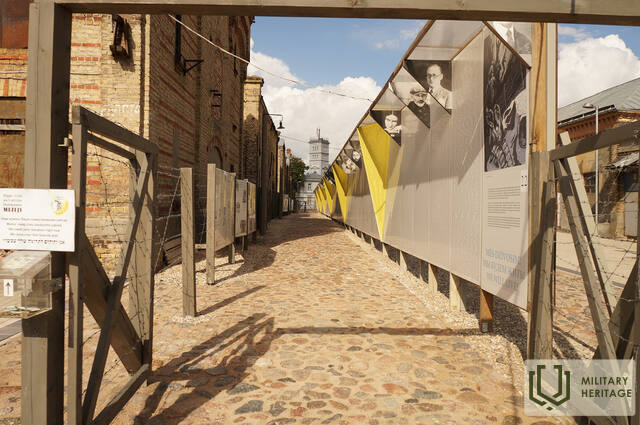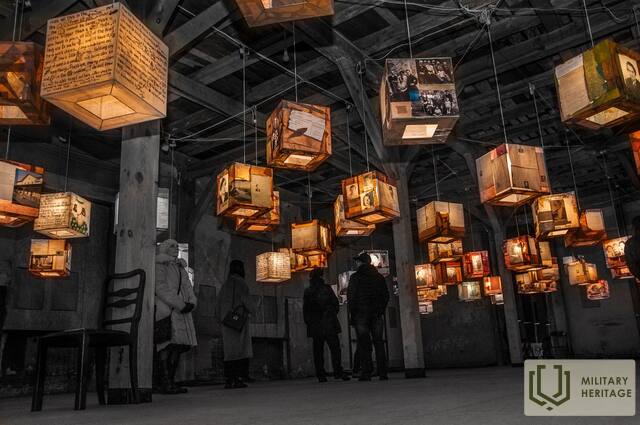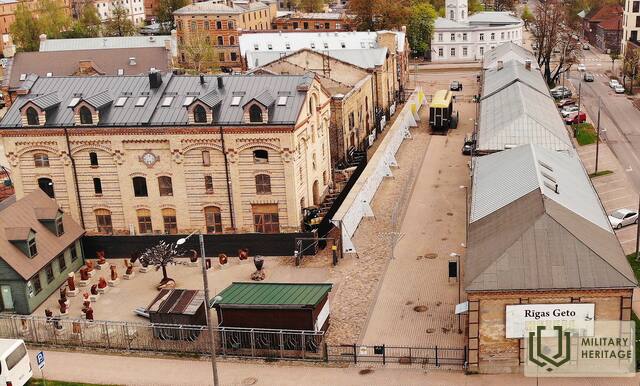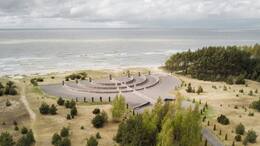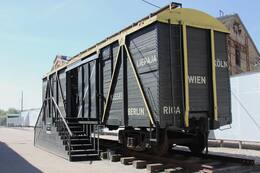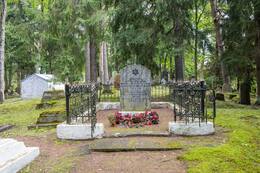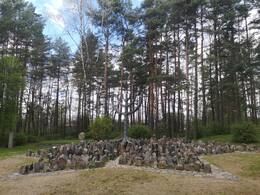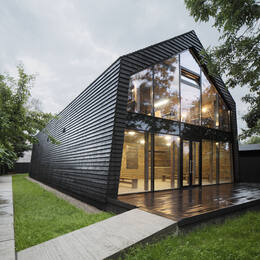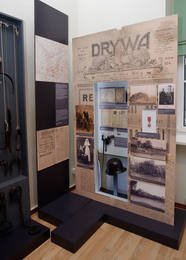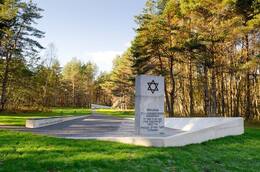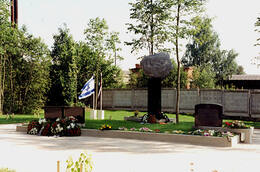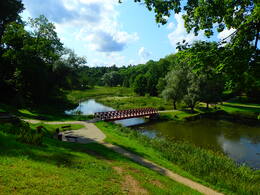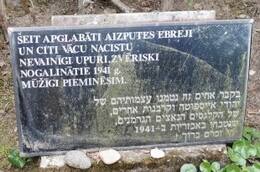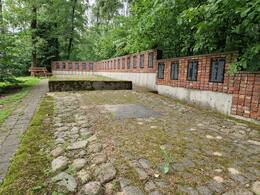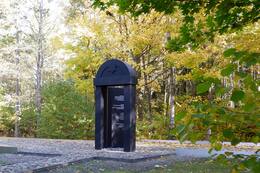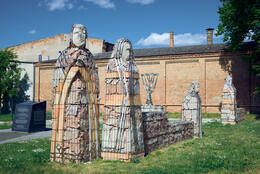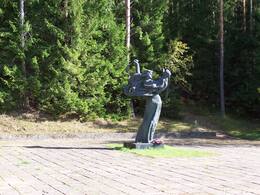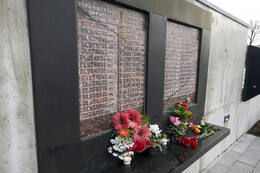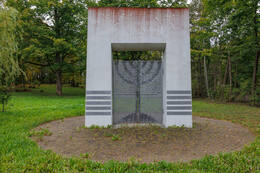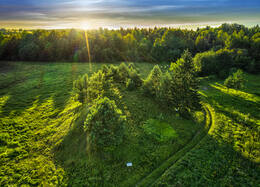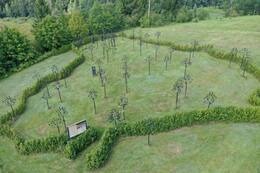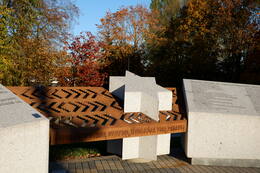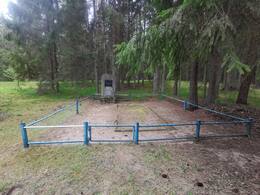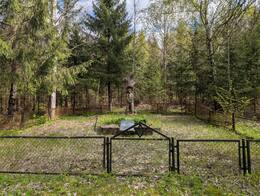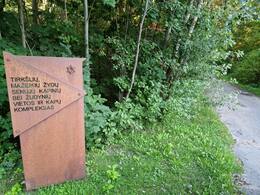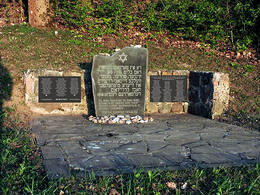Holocaust II Zweiter Weltkrieg
Der Holocaust (griechisch: holos – alles, spurlos; kaustos – verbrannt) bezeichnet die Massenvernichtung der Juden im nationalsozialistischen Deutschland und den besetzten Gebieten während des Zweiten Weltkriegs. Der Prozess der Massenvernichtung der Juden begann mit der Besetzung Polens. Mit dem deutschen Überfall auf die Sowjetunion am 22. Juni 1941 begann die aktive Phase des Holocaust oder der Shoah (Katastrophe). Die geheime sogenannte „Endlösung der Judenfrage“ der Nationalsozialisten sah die Ermordung aller Juden auf dem Gebiet der UdSSR vor. In der zweiten Hälfte der 1930er Jahre lebten 93.479 Juden in Lettland (1935). Die meisten der während des Krieges dorthin deportierten deutschen, österreichischen, ungarischen und tschechoslowakischen Juden wurden ebenfalls in Lettland ermordet. Der Völkermord richtete sich auch gegen die lettischen Roma und psychisch Kranken. Der Holocaust ist das größte Massenverbrechen an Zivilisten in der Geschichte Lettlands – etwa 73.000 lettische Juden und 16.000 ausländische Juden kamen während der Nazi-Besatzung ums Leben.
Der Holocaust im deutsch besetzten Lettland wurde zunächst von der deutschen Sicherheitspolizei und der SD-Spezialeinheit Einsatzgruppe A – der größten von vier solchen Einsatzgruppen – durchgeführt. Sie stand unter der Führung von SS-Brigadegeneral und Polizeigeneralmajor Walter Stahlecker. Zunächst wurden verschiedene Einschränkungen und Verbote eingeführt, dann wurden Juden registriert und gezwungen, das Symbol des Judentums – den sechszackigen Davidstern – auf ihre Kleidung zu nähen. Ihnen wurde ihr Eigentum entzogen, gefolgt von ihrer Isolation und schließlich ihrer Ermordung. Die ersten Morde ereigneten sich am 23. Juni 1941 in Grobiņa. Die deutschen Militär- und Zivilbehörden wollten ihre Macht festigen und die lokale Bevölkerung in die Morde einbeziehen. Sie fanden in allen Siedlungen statt, in denen es auch nur eine kleine Anzahl von Juden gab. Die Hauptverantwortlichen für die Morde waren eigens dafür aufgestellte SD-Einheiten unter der Führung von Viktors Arajs und Mārtiņš Vagulāns.
Jüdische Gebetsstätten – Synagogen – wurden niedergebrannt, und am 4. Juli brannte die Choral-Synagoge in der Gogoļa-Straße in Riga nieder, die in der zweiten Hälfte des 19. Jahrhunderts erbaut worden war. Am 23. August wurde in einem Moskauer Vorort ein Ghetto errichtet, in dem 29.602 Menschen inhaftiert wurden. 14.000 wurden im Ghetto Daugavpils und mehrere Tausend im Ghetto Liepāja interniert. Am 30. November und 8. Dezember 1941 wurden unter seiner Führung in Rumbula etwa 25.000 lettische Juden und 1.000 aus Deutschland deportierte Juden ermordet. Nach dem Massaker von Rumbula überlebten etwa 6.000 Juden, die zur Zwangsarbeit gezwungen wurden. 1944 wurden die Überlebenden in Lager nach Deutschland deportiert. Die deutschen nationalsozialistischen Besatzungsbehörden begingen auch Völkermord an den Roma (Zigeunern) Lettlands und an psychisch Kranken. In mehreren lettischen Städten wurden etwa 2.000 Roma getötet, und in psychiatrischen Kliniken in Riga, Daugavpils, Liepaja, Strenči usw. kamen etwa 2.327 Menschen ums Leben.
Weitere Informationsquellen
http://okupacijasmuzejs.lv/lv/aktualitates/4-julijs--ebreju-tautas-genocida-upuru-pieminas-diena-379/
Zugehörige Objekte
Holocaust-Gedenkstätte Liepāja
Unweit von Liepāja in den Dünen von Šķēde befindet sich die größte Holocaust-Gedenkstätte Lettlands. Das Denkmal ist den mehr als 3000 jüdischen Einwohnern der Region Liepāja gewidmet, die während des Zweiten Weltkriegs hier ermordet wurden. Die Anlage hat die Form einer Menora, des siebenarmigen Leuchters – eines der nationalen Symbole Israels. Die Umrisse der Gedenkanlage, die aus Bruchsteinen und Granitblöcken besteht, ist aus der Vogelperspektive am besten erkennbar. Die Lichter der Menora bestehen aus Granitsäulen, in die Verse aus den Klageliedern Jeremias auf Hebräisch, Englisch, Lettisch und Russisch eingemeißelt sind.
Museum des Rigaer Ghettos und des Holocausts in Lettland
Das Rigaer Ghetto- und lettische Holocaust-Museum befindet sich in der Nähe des Rigaer Zentralmarktes und des Hauptbahnhofes. Das Museum wurde 2010 im einstigen Speicherviertel eröffnet. Es liegt unweit der Grenze zum ehemaligen jüdischen Ghetto in einem historischen Stadtteil. Das einstige Ghettoterritorium ist eine Ausnahmeerscheinung, da es sich seit dem Zweiten Weltkrieg architektonisch kaum verändert hat. Es ist wie ein Mahnmal für die Tragödie des jüdischen Volkes. Bis Ende 1939 drängten deutsche Diplomaten und Politiker die lettische Regierung zu Maßnahmen gegen Juden, um deren Freiheiten einzuschränken. Seit der Umsiedlung der Deutschbalten 1939 war die deutsche Gesandtschaft weniger über die Stimmung in der Bevölkerung und die Lage in Lettland in der sog. Judenfrage im Bilde. Mit dem Einrücken der Roten Armee in Lettland und der damit einhergehenden Manipulation der Öffentlichkeit unterstützte ein erheblicher Teil der jüdischen Einwohner die sowjetische Besatzungsmacht. Angesichts des harten Vorgehens des Regimes gegen die Gesellschaft als Ganzes ging die Unterstützung bald deutlich zurück. In der Bevölkerung hatte sich jedoch eine tiefe Kluft gebildet, die später vom deutschen Besatzungsregime ausgenutzt wurde. Die neue Besatzungsmacht hatte vergeblich auf ausbrechende Pogrome und Schikanen gegen jüdische Einwohner gesetzt. Die deutschen Pläne wurden dahingehend geändert, dass zunächst Ghettos für Juden gebildet, dann aber ihre Bewohner umgebracht wurden.
Jüdischer Friedhof Varakļāni – ein Denkmal für die Opfer des deutsch-faschistischen Terrors
Jüdischer Friedhof Varakļāni, am Ende der Kapsētas-Straße.
Zwei Denkmäler sind zu sehen, die nach dem Krieg von überlebenden Verwandten und Freunden auf dem jüdischen Friedhof von Varakļāni errichtet wurden.
Eines der Denkmäler befindet sich in der Nähe des Friedhofszauns, wo die Massenvernichtung der Juden stattfand. Die Inschrift in Russisch und Jiddisch lautet: „Wir werden für immer um unsere Eltern, Brüder und Schwestern trauern, die 1941 durch die Hand der Faschisten starben.“ Das zweite Denkmal steht auf dem Friedhofsgelände, an der Stelle, wo die ermordeten Juden später umgebettet wurden. Auch hier befindet sich eine Inschrift in Jiddisch und Russisch: „Ewiges Gedenken den Opfern des deutsch-faschistischen Terrors – den Juden von Varakļāni, die am 4. August 1941 brutal ermordet wurden.“
Anfang Juli 1941 marschierten nationalsozialistische Truppen in Varakļāni ein und begannen von Beginn an mit der Verfolgung und Ermordung von Juden. In der Nähe des jüdischen Friedhofs wurde ein provisorisches Ghetto errichtet, in das alle Juden umgesiedelt werden mussten. Am 4. August erschoss eine deutsche SD-Einheit („Arāja komanda“) auf dem Gelände des jüdischen Friedhofs mit Unterstützung lokaler Selbstverteidigungskräfte nahezu alle Juden von Varakļāni (etwa 540 Personen).
Jedes Jahr am ersten Sonntag im August findet auf dem jüdischen Friedhof von Varakļāni eine Gedenkveranstaltung für die in Varakļāni getöteten Juden statt.
Jüdisches Denkmal in Rumbula
Das Hotel liegt in Rumbula, in der Nähe der Maskavas-Straße.
Rumbula zählt zu den größten Orten der Massenvernichtung von Juden in Europa. Bei zwei Aktionen – am 30. November und 8. Dezember 1941 – die auf Beschluss der NS-Führung zur vollständigen Vernichtung der im Rigaer Ghetto inhaftierten Juden durchgeführt wurden, wurden im Wald von Rumbula über 25.000 Menschen erschossen, darunter etwa 1.000 aus Deutschland deportierte Juden. Bereits 1944 wurden in Rumbula mehrere hundert jüdische Männer aus dem Konzentrationslager Kaiserwald ermordet.
Die ersten Versuche, das Andenken an die in Rumbula ermordeten Juden zu bewahren, datieren aus den späten 1960er Jahren. Trotz der Einschränkungen der sowjetischen Regierung wurde 1963 auf Initiative einzelner Juden eine hölzerne Gedenktafel mit jiddischer Inschrift an einer Kiefer in Rumbula angebracht. Gleichzeitig wurde in der Nähe der Bahnstrecke Rumbula (nahe der Bahnlinie Riga–Moskau) ein großes Plakat mit dem Titel „Jude“ des Künstlers Josif Kuzkovskis aufgehängt. Das Plakat zeigte einen Mann, der mit geballter Faust aus dem Grab zu steigen schien und symbolisierte so den Protest gegen das Geschehene. Gedenktafel und Plakat wurden 1964 entfernt, doch den Juden gelang es, die Genehmigung zu erhalten, in Rumbula einen Gedenkstein mit der Inschrift „Den Opfern des Faschismus“ in lettischer, russischer und jiddischer Sprache aufzustellen.
Am 29. November 2002 wurde in Rumbula eine Gedenkstätte eröffnet, die vom Architekten Sergejs Rižs entworfen wurde. Ihr Bau wurde finanziell von Institutionen aus Lettland, Israel, den USA und Deutschland sowie von Privatpersonen unterstützt.
Am Straßenrand, an der Zufahrtsstraße zum Mahnmal, wurde eine Metallkonstruktion als Symbol für die nationalsozialistische Macht errichtet. In der Nähe erinnert ein Stein daran, dass Tausende Juden auf dieser Straße in den Tod getrieben wurden. Am Eingang des Mahnmals selbst erläutern mehrere Steintafeln mit Inschriften in Lettisch, Englisch, Deutsch und Hebräisch die Ereignisse der Tragödie von Rumbula und die Entstehungsgeschichte des Mahnmals. Im Zentrum des Mahnmals, über dem Platz in Form eines Davidsterns, erhebt sich ein siebenarmiger Leuchter – eine Menora –, um den herum Steine mit den Namen der in Rumbula ermordeten Juden angeordnet sind. Die Namen der Straßen des ehemaligen Rigaer Ghettos sind in die einzelnen Steine eingraviert, mit denen der Platz gepflastert ist. Auf dem Gelände des Mahnmals befinden sich mehrere Massengräber, deren Gräber mit rechteckigen Betonrändern markiert sind.
Žanis-Lipke-Gedenkstätte
Die Žanis-Lipke-Gedenkstätte befindet sich im Rigaer Stadtteil Ķīpsala. Sie ist wohl das am besten „versteckte“ Museum Rigas. Dies ist real, aber auch symbolisch gemeint. Das Museum entstand nämlich an jenem Ort, an dem sich im Zweiten Weltkrieg unter deutscher Besatzung ein rettender bunkerartiger Unterschlupf für Menschen befand. Žanis Lipke und seine Familie versteckten hier 55 Juden. Heute steht neben dem Haus von Žanis Lipke eine Gedenkstätte: der Erinnerungsbau – „der schwarze Schuppen“ – ist ein symbolisches Bauwerk, in dem Zuflucht gewährt und empfangen wurde. Das Aussehen des Gebäudes ist den alten Fischer- und Seemannsschuppen auf Ķīpsala entlehnt, die aus Strusenholz (Lastbarkenholz) mit der charakteristischen Farbe gebaut waren und den typischen Teergeruch verströmten. Nicht nur die historische Stätte ist einzigartig, sondern auch die Art und Weise, wie das Museum mit seinen Besuchern kommuniziert. Die Form erinnert konzeptionell und visuell an die biblische Arche Noah, sowie ein an Land gezogenes und auf den Kopf gestelltes Boot. Ein Boot, das seine Beförderungsfunktion erfüllt hat. Das Konzept der Gedenkstätte basiert auf der Authentizität des Ortes, der Geschehnisse, die sich hier abgespielt haben, und den dazugehörigen Zeitzeugnissen. Es ist eine Geschichte von der Sehnsucht der Menschen nach Freiheit, ihrer unglaublichen Errettung und ihr Vertrauen. Auf dem Weg zum Museum können Sie auch die historische Bebauung der links der Daugava gelegenen Stadtteile Rigas (Pārdaugava) erkunden.
Ausstellung des Museums für Geschichte und Angewandte Kunst in Preiļi „Museumsgeschichten für Lettland“
Befindet sich auf dem Gelände des Preiļi Kulturzentrums.
Die Ausstellung „Museumsgeschichten für Lettland“ im Museum für Geschichte und Angewandte Kunst Preiļi (PVLMM) über den Ersten Weltkrieg, den Unabhängigkeitskrieg und den Zweiten Weltkrieg ist zu sehen.
Der Abschnitt „Die Geschichte von Drywys“ der Ausstellung „Museumsgeschichten für Lettland“ im Geschichts- und Kunstmuseum Preili (Eröffnung 2018) widmet sich dem Ersten Weltkrieg, dem Unabhängigkeitskrieg und der Befreiung Latgales sowie den Rittern des Lāčplēšana-Kriegsordens. Der Abschnitt „Die Geschichte der Flagge“ schildert die komplexen Ereignisse des Zweiten Weltkriegs, in dem die Bevölkerung von Preili von Deportationen, dem Holocaust, der Beteiligung an den Militäreinheiten der Kriegsparteien und nach dem Krieg an der Partisanenbewegung betroffen war. Auch die Medaille „Gerechter unter den Völkern“, die dem Einwohner von Preili und jüdischen Retter Vladislavs Vuškāns verliehen wurde, ist dort ausgestellt.
Führungen sind nach vorheriger Absprache auch in russischer und englischer Sprache möglich.
Konzentrationslager Klooga und Holocaust-Gedenkstätte
Das Holocaust-Mahnmal befindet sich in unmittelbarer Nähe des Dorfes Klooga.
Das erste Mahnmal wurde 1951 auf dem Gelände des ehemaligen Konzentrationslagers errichtet, doch vermittelte dieses vor allem die sowjetische Ideologie, in der die Opfer des Holocaust kaum Erwähnung fanden. Im Jahr 1994 wurden auf Antrag der estnischen jüdischen Gemeinde die Gedenktafeln durch neue ersetzt. Nun gedachte man insbesondere der jüdischen Opfer. Anlässlich des 50. Jahrestages des Massakers von Klooga wurde 100 Meter von der bestehenden Gedenkstätte entfernt ein Mahnmal für die zwischen 1941 und 1944 in Estland ermordeten Juden eingeweiht. 2005 wurde ein drittes Denkmal errichtet, das an die im Konzentrationslager Klooga vernichteten Juden erinnert.
Die Gedenkstätte wurde 2013 gründlich erneuert. Dabei wurden die zu verschiedenen Zeiten errichteten Gedenkstätten zusammengeführt und eine Ausstellung im Estnischen Geschichtsmuseum mit dem Titel "Das Lager Klooga und der Holocaust" eröffnet.
Das Konzentrationslager Klooga wurde im September 1943 von den deutschen Besatzern errichtet. Es war ein Zwangsarbeitslager, Teil des Vaivara-Lagersystems in Estland. Am 19. September 1944 fand in Klooga einer der größten Massenmorde im von Deutschland besetzten Estland statt: Kurz vor dem Einmarsch der Roten Armee wurden fast alle 2.000 Juden, die sich zu diesem Zeitpunkt im Lager befanden, hingerichtet.
Preili Holocaust-Gedenkstätte
Das Gebäude befindet sich auf dem jüdischen Friedhof Preiļi in der Cēsu-Straße.
Der Architekt des Denkmals ist Sergejs Rižs. Es wurde am 8. August 2004 eingeweiht. Das Denkmal entstand auf Initiative und mit privaten Mitteln des ehemaligen Einwohners von Preiļi, Ingenieurs und Persönlichkeit des öffentlichen Lebens, David Zilbermanis (USA). Im Jahr 2015 wurde dem Denkmal ein weiteres Monument hinzugefügt – ein Bogen, der als symbolisches Tor am Eingang des Friedhofs errichtet wurde.
Das Denkmal befindet sich am Rande des jüdischen Friedhofs von Preiļi, neben dem Ort, an dem im Sommer 1941 nach dem Einmarsch nationalsozialistischer Truppen mit Unterstützung lokaler Kollaborateure etwa 800 Juden aus Preiļi und Umgebung ermordet wurden. Als Zeugnis dieser Ereignisse dient das Tagebuch der jüdischen Preiļi-Frau Šeina Grama (1926–1941), das sie am 22. Juni – dem Tag des Kriegsbeginns zwischen der UdSSR und Deutschland – begann und bis zum 8. August führte. Šeina wurde am 9. August zusammen mit ihrer Familie und anderen überlebenden Preiļi-Juden neben dem jüdischen Friedhof ermordet. Dank der Hilfe von Vladislavs Vuškāns (1887–1953), einem Einwohner von Preiļi, konnten sechs Juden aus Preiļi die deutsche Besatzung im Versteck überleben. Die Steine des Denkmals tragen eingravierte Einträge aus Sheina Grams Tagebuch sowie Dankesworte an den jüdischen Retter Vladislavs Vuškāns. Am Fuße des Denkmals befindet sich eine Urne mit den Namen von 750 hier getöteten Juden.
Militärerbepfad von Misiņkaln
Der Naturpark Misiņkalns befindet sich in der Stadt Aizpute. Misiņkalns ist der höchste Ort in der Stadt Aizpute. Seine Höhe erreicht 95,4 m. Die Spitze bietet einen malerischen Blick auf die Stadt. Mit dem Bau des Naturparks Misiņkalns wurde im 20. Jahrhundert begonnen. anfangs. Die Fläche des Parks beträgt derzeit etwa 28 ha.
Auf dem Territorium des Parks gibt es mehrere Orte und Denkmäler, die mit den Ereignissen des 20. Jahrhunderts verbunden sind - die Gedenkstele der in den lettischen Freiheitskriegen gefallenen Soldaten - die Kavaliere des Lāčpleš-Ordens, der Ort des Holocaust-Mahnmals, die Ort der Erinnerung an die Unterdrückten und die Gedenktafel der gefallenen roten Partisanen.
Im Park können Sie die Pflanzen und Plantagen verschiedener seltener Arten kennenlernen und die unberührte Natur genießen. Derzeit ist der Park von renovierten Wander- und Radwegen durchzogen, und auf dem Territorium des Parks befindet sich eine Motorradstrecke, auf der lettische Motocross-Wettkämpfe stattfinden.
Um das kulturelle und historische Erbe des Gutsparks von Misiņkaln besser kennenzulernen, empfehlen wir Ihnen, die Dienste eines Fremdenführers in Anspruch zu nehmen.
Umbettungsstätte für Holocaust-Opfer
Am 28. Juni 1941 marschierten Nazi-Truppen in Aizpute ein. Bereits Anfang Juli wurden einzelne Juden im Dzirkaļi-Wald und im Stadtpark erschossen, während die übrigen Juden aus der Stadt und der Umgebung verhaftet und in zwei Stadtsynagogen untergebracht wurden.
Der Massenmord an den Juden erfolgte dann im Rahmen zweier Feldzüge.
Heute steht an der Umbettungsstätte ein Denkmal mit einer Inschrift in Hebräisch und Lettisch: „Hier sind die Juden von Aizpute und andere unschuldige Opfer der deutschen Nazis begraben, die 1941 brutal ermordet wurden. Wir werden ihrer für immer gedenken.“
Holocaust-Denkmal in Kaušėnai
Im Dorf Kaušėnai (Bezirk Plungė) wurde an der Stelle, an der die Juden ermordet wurden, eine Gedenkstätte für die Opfer des Holocausts von Kaušėnai errichtet. Das Denkmal ist den jüdischen Gemeinden von Plungė und den umliegenden Dörfern gewidmet, die während des Zweiten Weltkriegs vernichtet wurden. Das Denkmal wurde auf Initiative des letzten Juden von Plungė, Jakov Bunka, errichtet. Das erste Denkmal für die Opfer des Zweiten Weltkriegs wurde 1952 errichtet, und in den Jahren 1986–1989 wurde ein Mahnmal für die getöteten Juden aus Eichenholz errichtet. Im Jahr 2011 wurden die 1800 Ziegelsteine der abgerissenen Plungė-Synagoge zum Bau der Gedenkmauer verwendet, an der jeder Ziegelstein dem Gedenken an die Ermordeten gewidmet ist; an der Wand sind Tafeln mit den bekannten 1200 (von 1800) jüdischen Namen angebracht. In der Nähe des Denkmals befindet sich die Allee der Retter, auf deren Pfosten die Namen derjenigen stehen, die während der Nazi-Besetzung die verurteilten Juden in Plungė und Umgebung gerettet haben. Am 12. und 13. Juli 1941 wurden etwa 1.800 Juden aus dem Kreis Plungė auf dem Kaušėnai-Hügel ermordet, nachdem sie zwei Wochen lang unter grausamen Bedingungen in der Synagoge von Plungė festgehalten worden waren. Am Tag des Völkermords wurden diejenigen, die zu Fuß gehen konnten, fünf Kilometer zum Ort der Hinrichtung getrieben, während die übrigen in getrennten Gruppen mit Lastwagen transportiert wurden. Den Opfern wurde befohlen, für sich Gruben zu graben, und dann wurden sie erschossen. Das Denkmal ist eine der zehn eindrucksvollsten Gedenkstätten in Europa, die an die Tragödie des jüdischen Volkes erinnern.
Holocaust-Stätte in Šeduva, Dorf Pakuteniai
Eine der drei Holocaust-Stätten von Šeduva befindet sich im Pakuteniai-Wald (Bezirk Radviliškis), etwa acht Kilometer südöstlich von Šeduva, an einer Schotterstraße. Im August 1941 wurden hier 27 Juden ermordet, darunter der letzte Rabbiner von Šeduva, Mordechai Dovid Henkin. An zwei weiteren Orten wurden im Wald von Liaudiškiai rund 700 Menschen getötet. Am 25. Juni 1941 besetzten die Nazis Šeduva und Anfang Juli wurden die Juden der Stadt gewaltsam aus ihren Häusern vertrieben und in das benachbarte Dorf Pavartyčiai gebracht, wo ein Ghetto eingerichtet wurde. Am 25. und 26. August wurde ein kleiner Teil der Gefangenen in Pakuteniai und der Rest im Wald von Liaudiškiai erschossen. 2014–2015 wurden auf Initiative der Jüdischen Gedenkstiftung Šeduva die Standorte dieser Morde gepflegt und für Besucher zugänglich gemacht. Das Denkmal „Zuhause des Lichtsternes“ des Bildhauers Romas Kvintas steht an der Stelle, an der die Juden des Dorfes Pakuteniai ermordet wurden.
Ort des I und II Holocausts in Šeduva
Die Holocaust-Stätten Šeduva I und II befinden sich im Wald von Liaudiškiai (Bezirk Radviliškis), etwa 10 km südlich von Šeduva. An der Schotterstraße ist ein Wegweiser angebracht. Die erste jüdische Begräbnisstätte ist 375 m² groß, größtenteils gepflastert und von Wald umgeben. Rund 400 Menschen wurden an diesem Ort ermordet und begraben. Etwa 500 m entfernt befindet sich eine zweite Grabstätte. Die sterblichen Überreste von Juden sind auf einer Fläche von 144 m² begraben. Das Gelände ist flach und größtenteils gepflastert. Rund 300 Menschen wurden an diesem Ort ermordet und begraben. Im Jahr 1941 wurde die gesamte jüdische Gemeinde von Šeduva – fast 700 Menschen – an diesen Orten ermordet. Einen Monat vor ihrem Tod wurden sie noch in dem im Dorf Pavartyčiai eingerichteten Ghetto festgehalten. Am 25. und 26. August wurden die Bewohner des Ghettos in den Wald von Liaudiškiai gebracht. Die Menschen wurden an eine ausgehobene Grube gebracht und von örtlichen Polizisten und Hilfskräften auf Befehl der Deutschen getötet. Unter den Opfern waren 230 Männer, 275 Frauen und 159 Kinder. 2014–2015 wurden auf Initiative der Jüdischen Gedenkstiftung Šeduva die Standorte dieser Morde gepflegt und für Besucher zugänglich gemacht. An den Orten der Massenmorde wurden zwei Statuen des Bildhauers Romualdas Kvintas aufgestellt: „Tür“ und „Strahl – Stern“.
Gedenkstätte „Synagogengarten“
Die Gedenkstätte befindet sich im Stadtzentrum, in der Nähe des Touristeninformationszentrums der Region Bauska und des Rathausplatzes.
Es entstand dank der Initiative und der Spenden der Nachkommen von Juden aus Bauska in Israel, den USA und Großbritannien sowie der Unterstützung durch den Stadtrat von Bauska und die lettischen jüdischen Gemeinden und Gemeinschaften.
Die Gedenkstätte wurde von dem Bildhauer Ģirts Burvis entworfen. Sie ist so groß wie die ehemalige Große Synagoge von Bauska und die Steinfiguren symbolisieren die Juden, die nach dem Gottesdienst aus der Kirche kommen. In der Mitte der Gedenkstätte befindet sich eine symbolische Bima, ein erhöhtes Podest oder ein Tisch, der bei jüdischen religiösen Ritualen in der Synagoge verwendet wird. Dort gibt es eine Inschrift: „Widmung an die Juden von Bauska, die hier jahrhundertelang gelebt und diese Stadt aufgebaut haben und die 1941 von den Nazis und ihren örtlichen Helfern umgebracht wurden. Zu Ehren des jüdischen Volkes – die Nachkommen der Juden von Bauska und Einwohner von Bauska.“
Im Jahr 1935 lebten fast 800 Juden in Bauska. Nach der Besetzung durch die Nazis im Juli 1941 wurden viele Juden verhaftet und deportiert, etwa 700 wurden erschossen. Die Große Synagoge von Bauska wurde während des Zweiten Weltkriegs zerstört.
Denkmal für die Opfer des Zweiten Weltkriegs in Ančupāni
Das Denkmal befindet sich in Ančupāni, Bezirk Rēzekne. Es wurde geschaffen, um der Tragödie von Audriņi zu gedenken – der Vernichtung der Zivilbevölkerung während der deutschen Besetzung durch Nazis, die 1942 im Dorf Audriņi, Gemeinde Makašāņi, Kreis Rēzekne, stattfand.
Seit Herbst 1941 versteckten sich mehrere entkommene Kriegsgefangene der Roten Armee in Audriņi. Am 18. Dezember 1941 wurde ihr Aufenthaltsort entdeckt, und vier Hilfspolizisten wurden bei dem Beschuss getötet. Am 24. Dezember wurden 203 Einwohner von Audriņi verhaftet und im Gefängnis von Rēzekne inhaftiert. Am 3. Januar 1942 wurden die meisten Verhafteten in der Nähe des Ančupāni-Hügel, etwa 5 km von Rēzekne entfernt, erschossen, und am 4. Januar wurden 30 Männer, die im Dorf Audriņi verhaftet worden waren, auf dem Marktplatz von Rēzekne öffentlich erschossen, und das Dorf selbst wurde niedergebrannt. Die Gedenkstätte wurde am 27. Juli 1974 eröffnet. Der Autor ist Landschaftsarchitekt Alfons Kišķis (1910–1994). Die immergrünen Tannen auf der rechten Straßenseite symbolisieren die zum Erschießen aufgereihten Menschen, während die Steinmauer auf der gegenüberliegenden Straßenseite die Schützen darstellt. Im unteren Teil, dem Tal des Leidens, führt ein mit Steinen übersäter Weg an den Massengräbern der Erschossenen vorbei und endet an einer Betonwand mit der Inschrift: „Sie sind gestorben, damit du leben kannst.“ Dann führt eine Treppe zum Platz des Lebens, dessen zentrale Skulptur „Mutter Apfelbaum“ von der Bildhauerin Rasa Kalniņa-Grīnberga (1936) stammt.
Denkmal für die Opfer des Dorfes Audriņi
Eine Gedenktafel am ehemaligen Gefängnis von Rēzekne, die 1965 eingeweiht wurde, ist den dreißig Männern aus dem Dorf Audriņi in der Gemeinde Makašēni gewidmet, die am 4. Januar 1942 an diesem Ort öffentlich erschossen wurden. Die Namen der 30 erschossenen Männer sind in die Tafel eingraviert.
Kurz zuvor war entdeckt worden, dass sich entflohene Kriegsgefangene der Roten Armee im Dorf Audriņi versteckt hielten. Bei den bewaffneten Auseinandersetzungen, die während ihrer Gefangennahme ausbrachen, wurden vier Hilfspolizisten getötet. Die nationalsozialistischen Besatzungsbehörden ordneten daraufhin als Vergeltung die Ermordung aller Einwohner von Audriņi und die Niederbrennung des Dorfes an. Die öffentliche Hinrichtung in Rēzekne war Teil dieser Vergeltungsaktion.
Holocaust-Mahnmal
Im August 2004 wurde in Preiļi, genauer gesagt in der Cēsu-Straße, eine Holocaust-Gedenkstätte eröffnet. Architekt war Sergejs Rižs, die Idee dazu stammte von David Zilbermanis, einem in den USA lebenden Einheimischen, der auch die Finanzierung übernahm. Die Gedenkstätte befindet sich zwischen den Gräbern jüdischer Bürger und den ehemaligen Erschießungsgruben jüdischer Einwohner.
Die ersten Juden kamen Anfang des 19. Jahrhunderts nach Preiļi, als sich die Stadt zu entwickeln begann. Laut Volkszählung von 1935 waren von den 1.662 Einwohnern Preiļis 847 (51 %) Juden. Die meisten von ihnen waren Kaufleute, Handwerker oder Intellektuelle – Ärzte und Lehrer.
Als die deutsche Wehrmacht am 28. Juli 1941 einmarschierte, wurden am 9. und 10. August mehr als 720 Juden aus Preiļi und Umgebung ermordet. Nach dem Krieg kehrten einige Juden nach Preiļi zurück, aber die Gemeinde wurde nie wieder aufgebaut.
In den Jahren 2013 und 2014 führten Schüler des Deutschen Jugendverbands LOT unter der Leitung von Klaus Peter Rex Aufräum- und Denkmalreinigungsarbeiten auf dem Jüdischen Bürgerfriedhof durch. Dabei wurde ein Friedhofsplan erstellt. 2015 wurde auf Initiative von David Zilbermanis und dank seiner finanziellen Unterstützung und Spenden ein Gedenkbogen für die jüdische Gemeinde in Preili am Eingang des Jüdischen Bürgerfriedhofs, auf dem Weg zum Holocaust-Mahnmal, eingeweiht.
Im Jahr 2018 führte die Preiļi-Gedenkgesellschaft (Vorsitzender Sergejs Rižs) Ausgrabungen an der Stätte der Judenmorde neben dem jüdischen Friedhof durch. Dabei wurden drei Gruben entdeckt. Die konservierten Fundstücke sind in der Hauptausstellung des Museums für Geschichte und Angewandte Kunst Preiļi am Raina Boulevard 28 zu sehen. Museumsfachleute bieten Besuchern das Bildungsprogramm „Über den Holocaust nachdenken heißt, über sich selbst nachzudenken“ an. Das Programm beginnt in der Museumsausstellung und endet an der Holocaust-Mahnmal. Die Mahnmalstätte und der Friedhof dienen als Freilichtmuseum der öffentlichen Aufklärung.
Jüdische Holocaust-Stätte in Kražiai (in der Nähe von Medžiokalnis)
Am Fuße des Medžiokalnis-Hügels, in der Nähe der Stadt Kražiai, befinden sich der Ort und das Grab des Massakers an den Juden von Kražiai.
Vor dem Zweiten Weltkrieg lebten in Kražiai etwa 1.500 Menschen, darunter rund 80 jüdische Familien – insgesamt 450 bis 500 Einwohner jüdischer Herkunft. 1941 wurden die Juden von Kražiai in einem Ghetto in der Scheune des Gutshofs isoliert (später kamen auch Juden aus Karklėnai hinzu) und in mehreren Etappen ermordet.
Die Nazis versuchten aktiv, Litauer in den Holocaust zu verwickeln: Deutsche Offiziere forderten bei der Erschießung von Juden, dass jeder Polizist, Rebell, Partisan oder Weißarmist, der als Konvoimitglied in den Wald kam, mindestens einen seiner jüdischen Nachbarn oder Bekannten erschoss. Nach den Massakern von 1941 überlebten etwa 20 Personen der jüdischen Gemeinde Kražiai, die sich in Litauen versteckten oder in die Tiefen der UdSSR flohen.
Am 2. August 1941 ermordeten die Nazis und ihre Kollaborateure in der Nähe von Medžiokalnis mehr als 70 Kinder und mehrere erwachsene Juden. Der Historiker Stanislovas Buchaveckas nannte dieses Massaker den „Mord an jüdischen Kindern“.
An dieser Stelle steht heute ein Denkmal mit der Inschrift: „An dieser Stelle ermordeten die Nazis und ihre Kollaborateure am 2. August 1941 71 Juden aus Kražiai.“ Die hebräische Inschrift gibt an, dass 71 Juden aus Kražiai ermordet wurden: 6 Männer und Frauen sowie 65 Kinder.
Gedenkgarten von Litvaks
Im Jahr 2014 richtete die Wohltätigkeits- und Unterstützungsstiftung Jakovas Bunka den Gedenkgarten von Litvaks (litauische Juden) im Nationalpark Samogitien ein, etwa zwei Kilometer vom Zentrum von Plateliai entfernt, im Dorf Medsėdžiai. Er ist ein Denkmal, das den zerstörten jüdischen Gemeinden Litauens gewidmet ist. Der Garten bildet die Konturen Litauens nach, während die Orte, an denen die jüdischen Gemeinden 1941–1944 zerstört wurden, durch schmiedeeiserne Apfelbäume gekennzeichnet sind. Die geschnitzten Apfelbäume stammen von Artūras Platakis. Die Äpfel auf den Bäumen sind Familien, die in Gemeinschaften gelebt haben. Litvaks in aller Welt können sich an dem Garten beteiligen, indem sie neue Apfelbäume und Äpfel zum Gedenken an ihre Vorfahren bestellen. Im Garten stehen auch karelische Granitsäulen, die die Leistungen von Litvaks weltweit würdigen. Im Jahr 2016 wurde die Initiative auf die Litvaken, die im gesamten Gebiet des Großfürstentum Litauen lebten, und auf die Retter der Juden während des Holocausts ausgeweitet. Eine Tafel am Eingang des Gartens erzählt die Geschichte der ehemaligen jüdischen Gemeinden in ganz Litauen. Derzeit „wachsen“ im Garten bereits Apfelbäume zum Gedenken an die jüdischen Gemeinden von Alytus, Alsėdžiai, Kalvarija, Mosėdis, Plateliai, Plungė, Telšiai, Vabalninkas, Viekšniai und andere.
Platz für die Gerechten unter den Völkern (Denkmal)
Am 22. Oktober 2021 wurde in Šiauliai, an der Kreuzung der Ežero und Vilniaus Straße, der Platz (das Denkmal) „Gerechte unter den Völkern“ eingeweiht. Es ist das erste Denkmal für die „Gerechten unter den Völkern“ in Litauen. Das Denkmal wurde von dem aus Šiauliai stammenden Designer Adas Toleikis entworfen und von Sania Kerbelis, dem Vorsitzenden der jüdischen Gemeinde des Kreises Šiauliai, initiiert. Am Denkmal „Jungtis“ sind die Namen der „Gerechten unter den Völkern“ des Kreises Šiauliai eingraviert, die an 148 jüdische Retter erinnern, während künstlerische Akzente die Tore des Ghettos von Šiauliai darstellen. In Šiauliai gab es zwei Ghettos: das so genannte Kaukazo-Viertel und das EžeroTrakų-Straßenviertel. Körperlich kräftige und arbeitsfähige Menschen wurden in das erste Ghetto geschickt, Spezialisten (Ärzte, Mechaniker usw.) in das zweite. Das Ghetto Šiauliai wurde im Sommer 1941 auf Befehl des Kommandanten von Šiauliai eingerichtet und 1944 mit dem Rückzug der deutschen Truppen aufgelöst. Die übrigen Juden wurden in die Konzentrationslager Stutthof und Dachau gebracht. Mehr als 5.950 Juden waren im Ghetto inhaftiert. In der Zwischenkriegszeit lebten in Šiauliai etwa 6.500–8.000 Juden, von denen einige freiwillig ins Innere Russlands auswanderten. Nach dem Holocaust gab es nur noch etwa 350–500 Juden.
Jüdische Holocaust-Gedenkstätte Kražiai im Kuprė-Wald
Im Wald von Kuprė, etwa 13 Kilometer von der Stadt Kražiai entfernt, befinden sich die Stätte und das Grab des Massakers an den Juden von Kražiai.
Vor dem Zweiten Weltkrieg lebten in Kražiai etwa 1.500 Menschen, darunter rund 80 jüdische Familien – insgesamt 450 bis 500 Einwohner jüdischer Herkunft. Im Sommer 1941 wurden die Juden von Kražiai in einem Ghetto isoliert, das in der Scheune des Gutshofs eingerichtet worden war.
Am 26. Juli 1941 fand im Wald von Kuprė der Massenmord an den Juden von Kražiai statt. Etwa 300 Erwachsene und Jugendliche wurden mit Lastwagen in den Wald gebracht. Dort wurden sie in Gruppen aufgestellt und in die Lastwagen verladen. Auf dem Weg zum Ort des Massakers erhielt man ihnen Schaufeln – ein Zeichen dafür, dass die Opfer Gruben ausheben mussten. Die Juden gruben eine tiefe, längliche Grube im Wald von Kuprė. Anschließend wurden sie gezwungen, sich auszuziehen, und die Hinrichtung erfolgte systematisch: Die Opfer wurden zu fünft am Rand der Grube aufgestellt und in zwei Reihen erschossen – der erste in den Rücken oder die Brust, der zweite in den Kopf.
Die Morde wurden sowohl von Mitgliedern der örtlichen TDA (Nationalen Arbeitsschutzeinheit) als auch von deutschen Soldaten und Offizieren verübt. Sie verzögerten sich aufgrund eines liegengebliebenen Lastwagens und Widerstands im Ghetto Kražiai, als den Gefangenen klar wurde, dass die Abgeführten nicht zurückkehren würden. Aus diesen Gründen wurde die geplante Hinrichtung von zwölf sowjetischen Aktivisten am selben Tag nicht durchgeführt. Diese Personen wurden später in das Gefängnis Raseiniai verlegt, die meisten von ihnen wurden freigelassen.
Nach dem Massaker beschlagnahmten deutsche Sicherheitskräfte Wertgegenstände von Juden. Die Operation führte dazu, dass fast alle Mitglieder der jüdischen Gemeinde Kražiai über 12 Jahre ausgelöscht wurden.
Heute steht an der Stelle des Holocaust ein Denkmal, und die Stelle der Tötungsgrube ist von einem Zaun umgeben.
Gräber von Holocaust-Opfern in Šateikiai
Die Stätte und das Grab des Massakers an Frauen und Kindern der jüdischen Gemeinde von Salantai ist ein historischer Friedhof für Holocaust-Opfer im nordwestlichen Teil des Gebiets der Gemeinde Plungė, in Šateikiai Rūdaičiai (Ältestenrat Plateliai), 0,5 km nordöstlich der Straße Skuodas-Klaipėda, am nordwestlichen Rand des Waldes von Šateikiai.
Die Grabstätte ist rechteckig (10 x 10 m) und von einem Drahtgitterzaun umgeben. Im Nordwesten befinden sich ein einflügeliges, durchbrochenes Metalltor, dessen oberer Teil den Davidstern zeigt. Der Davidstern und eine Gedenkinschrift in Jiddisch und Litauisch sind in die monumentale Granitplatte eingraviert. 1980 wurde dort eine Holzskulptur eines stehenden, gefesselten Juden aufgestellt (Künstler: Volkskünstler Jakovas Bunka). Die Fläche des Geländes beträgt 0,01 ha.
An diesem Ort ermordeten Hilfspolizisten aus Salantai und Šateikiai im Juli/August 1941 Frauen und Kinder der jüdischen Gemeinde von Salantai. Die Exekution erfolgte in drei Phasen. Das erste Massaker fand um den 20. Juli 1941 statt. Auf Befehl der Polizei kamen Fuhrleute mit Karren im Morgengrauen aus den umliegenden Dörfern nahe der Synagoge von Salantai, wo jüdische Frauen und Kinder festgehalten wurden, und brachten, begleitet von Hilfspolizisten, etwa 60 bis 70 Frauen in den Wald von Šateikiai. Während des zweiten Massakers Ende Juli wurden die letzten verbliebenen Frauen und Kinder im Ghetto getötet, mehr als 50 an der Zahl. Ende August eskortierten Hilfspolizisten etwa 100 jüdische Frauen aus Salantai in den Wald von Šateikiai zur Exekution. Seit Juli hatten sie als landwirtschaftliche Hilfskräfte auf dem Gut Šalynas und bei Bauern in der Gemeinde Salantai gearbeitet.
Laut dem Holocaust-Atlas in Litauen sind hier 95 Opfer begraben. Die Gedenktafel am Grab und die Dokumentensammlung „Massenmorde in Litauen“ weisen darauf hin, dass hier 100 jüdische Männer, Frauen und Kinder getötet wurden. Paulius Vaniuchinas, ein Historiker von Salantai, ermittelte, dass an diesem Ort 210 bis 220 Frauen und Kinder ermordet wurden.
Der Ort des Massakers und der Beisetzung wurde 1970 zum historischen Denkmal von lokaler Bedeutung erklärt und 1993 in das Register des kulturellen Erbes aufgenommen.
Der Ort des Massakers an den Juden in Mažeikiai und seine Umgebung
Das Objekt befindet sich in der Nähe des alten jüdischen Friedhofs von Mažeikiai. Wenn man von Mažeikiai in Richtung Tirkšliai/Seda die Sedos-Straße (Straße 164) entlangfährt, befindet sich auf der linken Straßenseite ein Schild mit der Aufschrift „Friedhof der Opfer des jüdischen Genozids und des Zweiten Weltkriegs“.
Zu Beginn des Holocaust, am 1. Juli 1940, lebten etwa 1100 Juden in Mažeikiai. Ende Juni 1941, mit Beginn der deutschen Besatzung, wurden bis zu 1000 Juden verhaftet und in der Synagoge von Mažeikiai festgehalten. Mitte Juli wurden die etwa 40 Juden von Leckava in der Scheune der Familie Lačas in Mažeikiai eingesperrt, die Frauen und Kinder in der Scheune, die Männer in der Synagoge.
Am 29. Juli 1941 zwangen die in Mažeikiai eingetroffenen Deutschen die Juden, in der Nähe des jüdischen Friedhofs Gräber auszuheben. Am 30. Juli um 6 Uhr morgens begannen Massenmorde. Am ersten Tag erschossen die Deutschen, später setzten die örtlichen Weißen Garden die Morde fort. Anfang August wurden in der Nähe desselben Friedhofs auch Juden aus anderen Dörfern und sowjetische Aktivisten erschossen.
Am 7. Dezember 1944 wurden auf Anordnung der sowjetischen Kommission die Gräber exhumiert und gerichtsmedizinisch untersucht. Dabei stellte man fest, dass sich 3 km von Mažeikiai entfernt, am Ufer der Venta, auf dem jüdischen Friedhof fünf Gräber mit etwa 4.000 sterblichen Überresten befanden. Die Zahl der in der Nähe von Mažeikiai erschossenen Juden wird unterschiedlich angegeben – zwischen 3.000 und 4.000. Historische Forschungen legen jedoch nahe, dass diese Zahlen zu hoch sind; die tatsächliche Zahl der Opfer liegt bei etwa 2.500.
Das Objekt ist derzeit eine Touristenattraktion, die von allen an der Geschichte des militärischen Erbes Interessierten besucht werden kann.
Stätte und Gräber des jüdischen Massakers Plateliai (Jazminai-Hügel)
Ein Hügel namens Jazminų kalnas liegt am Rande der Stadt Plateliai. Am Fuße dieses Hügels wurden im Juli 1941 30 Juden aus Plateliai erschossen (einige Juden aus Plateliai wurden auf der Halbinsel Laumalenkai erschossen). In der Zwischenkriegszeit lebten etwa 100 Juden in Plateliai, doch „[…] das Schicksal war für alle gleich. Zuerst trieben sie, wie üblich, die Männer hier in der Nähe von Plateliai zusammen, wo das Denkmal steht – und erschossen sie dort. Ein paar Wochen später brachten sie die Frauen, Kinder und Alten hierher, außerhalb von Plateliai, einige Kilometer entfernt in den Wald, und erschossen sie dort“, sagte Eugenijus Bunka, der Sohn des Holocaust-Überlebenden und Volkskünstlers Jakovas Bunka.
Um 1985 schuf sein Vater, der Volkskünstler Jakovas Bunka, eine dekorative Moses-Skulptur und stellte sie auf dem Berg auf. 2016 stürzte die Skulptur ein, und 2018 wurde eine Kopie, geschaffen vom Volkskünstler Antanas Vaškis, errichtet.
Am Fuße des Berges wurde eine monumentale Granitplatte zum Gedenken an den jüdischen Genozid errichtet. Sie trägt Inschriften in Jiddisch und Litauisch: „Hier wurde das Blut von 30 Juden – Kindern, Frauen und Männern – vergossen. Sie wurden im Juli 1941 von Nationalisten und ihren einheimischen Kollaborateuren brutal ermordet. Das Andenken an die unschuldigen Opfer sei heilig.“ Im Jahr 2019 wurden zwei weitere Granitplatten mit einer Liste der 1939 in Plateliai lebenden Juden hinzugefügt.
Zugehörige Geschichten
Das Rigaer Ghetto und der Holocaust
Es wurden bewusst Fragmente aus den Memoiren dreier verschiedener Personen ausgewählt, um uns einen genaueren Blick auf das Verbrechen des Holocaust aus unterschiedlichen Perspektiven zu ermöglichen.
Davidstern an der Gedenkstätte des Konzentrationslagers Dundaga
Nach Wiedererlangung der Unabhängigkeit errichteten die Einwohner von Dundaga an der Stelle des Mordes und der Umbettung von Juden in der Nähe der Straße Mazirbe-Dundagas einen großen hölzernen Davidstern, und später enthüllte der Rat der jüdischen Gemeinden und Gemeinschaften Lettlands daneben einen Gedenkstein.
Der Mann, der die Verfolgten rettete
Bronius Gotautas, im Volksmund Broliuk genannt, riskierte während und nach dem Zweiten Weltkrieg sein Leben, um verfolgte Menschen zu retten – sowohl Juden als auch litauische Nationalisten und russische Soldaten.
Eine Liebesgeschichte, die im Krieg endete
Diese Geschichte erzählt von der Liebe und dem Überlebenskampf von Pranas Laucevičius und Rūta Gurvičiūtė während des Zweiten Weltkriegs. Sie zeugt von Mut, Opferbereitschaft und Tod, als die Gräueltaten des Krieges nationale Grenzen, nicht aber menschliche Gefühle, außer Kraft setzten.
Wie eine zweite Geburt
Im Juli und August 1941 massakrierten die Nazi-Behörden in Kražiai fast die gesamte Bevölkerung des Ortes. Marytė Gerčienė, eine Gefangene des Ghettos Kražiai und Kolchosbäuerin der Kolchose K. Požėla, überlebte diese Tragödie wie durch ein Wunder.
Massaker an jüdischen Frauen aus Salantai im Šateikiai-Wald
Im Sommer 1941 fand im Wald von Šateikiai ein Massaker an jüdischen Frauen und Kindern statt, das von der örtlichen Polizei und einer Miliz in weißen Roben verübt wurde. Die Opfer wurden von Salantai zum Ort des Massakers gebracht und vor ihrer Erschießung gezwungen, sich auszuziehen und in eine Grube zu springen. Verschiedenen Quellen zufolge wurden bei diesen Hinrichtungen zwischen 95 und 230 Menschen getötet, zumeist Frauen und Mädchen.
2.500 unglückliche Seelen beendeten ihr Leben in Mažeikiai.
Ende Juli 1941 begann in Mažeikiai ein Massenmord an Juden, der von den Deutschen initiiert und später von lokalen Wirtschaftskriminellen fortgesetzt wurde. Die Menschen wurden in Gruppen zum jüdischen Friedhof gebracht, gezwungen, sich auszuziehen, und in der Nähe von Gruben erschossen. Innerhalb weniger Tage wurden mehr als 2.000 Juden aus Mažeikiai und den umliegenden Ortschaften ermordet.
Litauische Retter – Miriam Javnaitė-Voronovas Überlebensgeschichte
Während des Zweiten Weltkriegs überlebte Miriam Javnaitė-Voronova den Holocaust dank vieler Litauer, die unter Einsatz ihres eigenen Lebens und des Lebens ihrer Angehörigen verfolgte Juden versteckten, ernährten und pflegten.
Die Heldentaten der Dorfbewohner von Šarnelė
Während des Zweiten Weltkriegs retteten zwei Familien aus dem Dorf Šarnelė – die Striaupiai und die Kerpauskas – trotz Lebensgefahr das Leben von Juden. Die Familie Striaupiai rettete insgesamt 26 Menschen, darunter neun Familien, und für die Familie eines jüdischen Kürschners aus Alsėdžiai wurde im Wald des Gehöfts der Kerpauskas ein Versteck eingerichtet.
Die Tragödie der Juden von Plateliai
Im Juli 1941 wurden 30 einheimische Juden auf dem Jazminų-Hügel in der Stadt Plateliai ermordet, und der Ort wurde später durch die dort stattgefundenen tragischen Ereignisse bekannt.
Das Schicksal der Juden von Plungė
Im Sommer 1941 wurde die jüdische Gemeinde von Plungė mit über 1800 Mitgliedern fast vollständig brutal ausgelöscht. Die Menschen wurden unter furchtbaren Bedingungen eingesperrt, dem Hungertod ausgesetzt und schließlich im Wald von Kaušėnai erschossen. Die Massenmorde wurden von einheimischen Kollaborateuren verübt.




